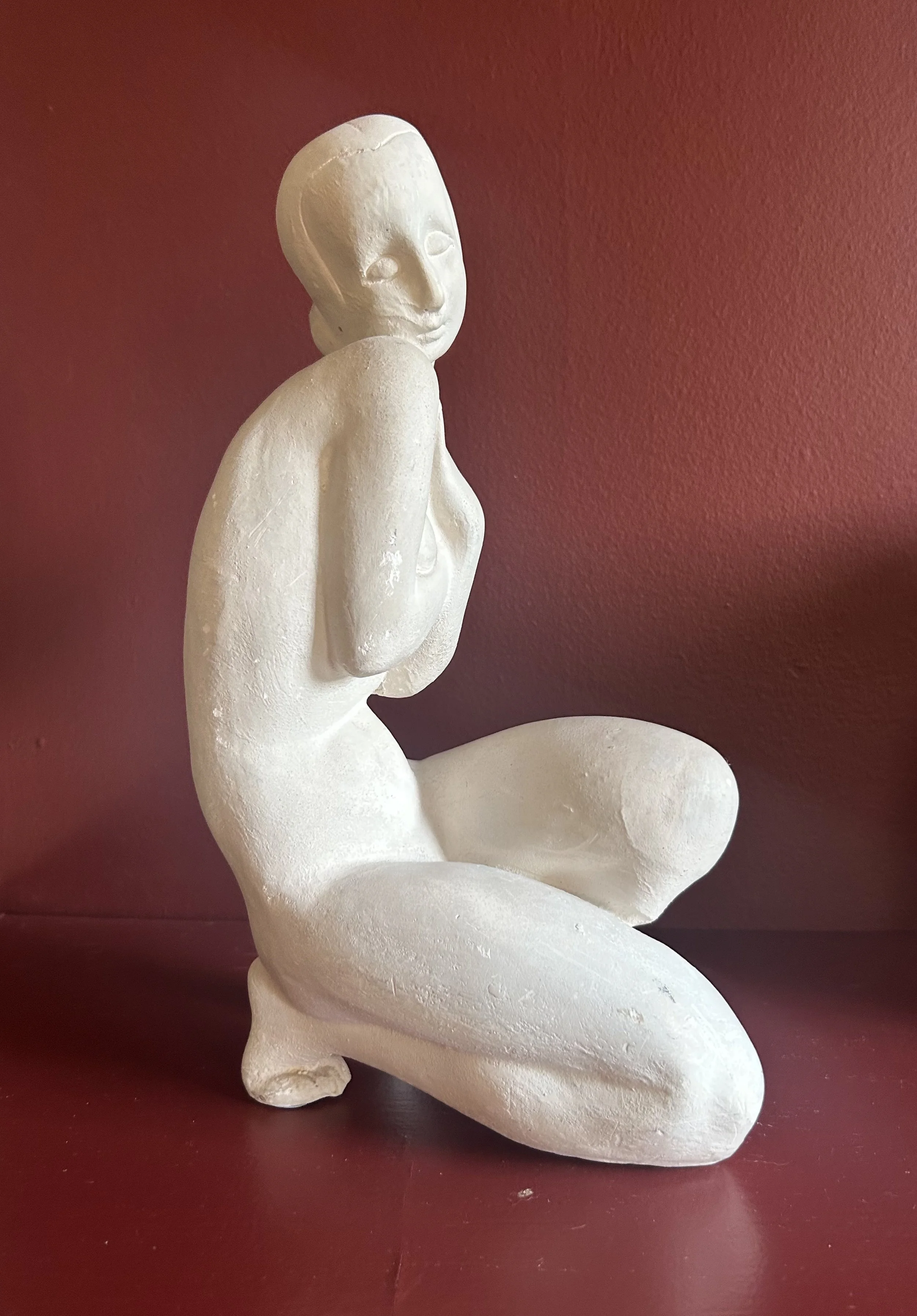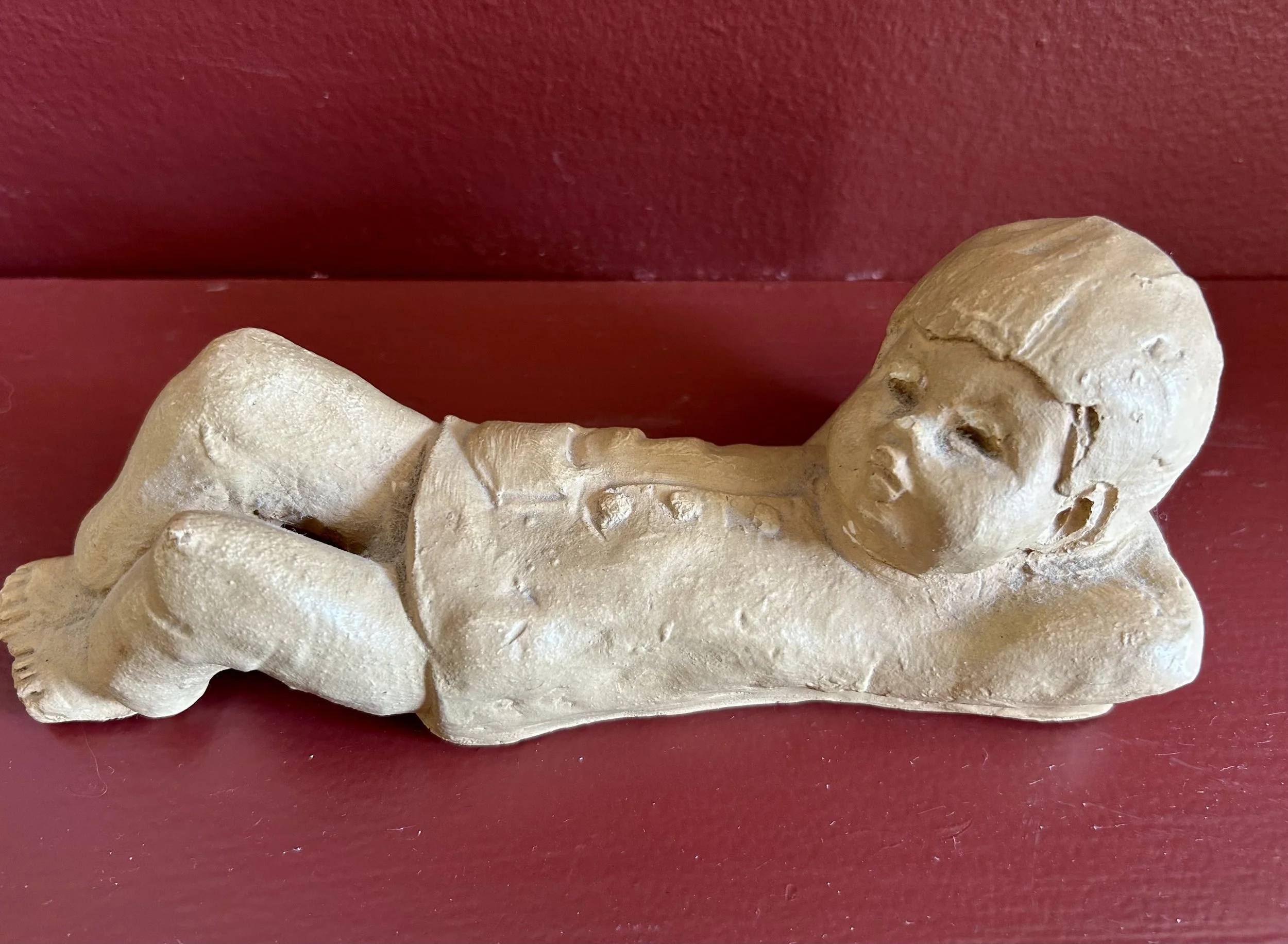Worth More Than Money
A local designer has hosted estate sales over the last year or so, and I twitch with anticipation when one is coming up. At the recent one, Hubby and I had fun gawking at vintage art, furniture and treasures, admiring many cool items. Most were way beyond our budget, so while I covet fabulous pieces, I have to contend myself with not so expensive treasures. When we first arrived at the sale, I saw this small statute and immediately picked her up. Not cheap by thrift store standards, but no matter: she was coming home with us.
She is not marked in any fashion, and the seller told me she was Deco and made of plaster. I guessed the era but was not familiar with plaster as a sculpture medium. Off to the internet. Turns out, Plaster of Paris has been used by artists for thousands of years. It is much like modeling clay, so the resulting piece is either directly molded by the artist’s hands or casted from a mold of an original design. It was used to build the pyramids of Egypt as well as Pompeii’s walls. For centuries, an area near Paris contained the needed gypsum to create the clay. In 1254 King Henry III visited Paris, was so impressed with the French’s fine white (plaster) walls, that he introduced the stuff to England where it became known as “Plaster of Paris”. Its use for actual artwork started in 16th century Italy.
During the estate sale, as my arms got full of finds, the staff carted the pieces to a table near the checkout area, one of many piles for fellow shoppers hunting for treasures. At one point hubby had a few things to add, and he carried his finds to the pile table. When he returned, I wondered if he found my pile, mentioning mine included a white female sculpture. Yeah, he says, I figured that was your pile. Made me laugh.
Clearly hubby recognizes I tend to pick up artwork with a female focus. When I brought my Deco girl home, I wandered around the house counting the female sculpture works scattered about: twenty three at the moment. I have written about many of them (15 plus a few more I have sold), and this doesn’t include paintings with feminine figures. For amusement sake, I then counted the male statuary – that didn’t take long! There are 5, three of which I have written about. One belonged to my mother-in-law, Lottie Jarrett (1926 - 1988).
This figure of a boy was one of three similar works Lottie owned. My husband’s father requested my two sisters-in-law and I each select a statues after Lottie had died. I don’t recall what the other 2 looked like, but in 1988 everyone said this statue represented my dreamer husband. As a newlywed, I found it a sweet thought, though the work isn’t something I would like normally (too “precious moments” for my taste). I am not clear if hubby is sentimental about it, but I have so few items from Lottie, that I have kept him. My counting exercise made me curious about the piece, and started research.
The artist, Ann Entis, worked at Dave Grossman Designs Inc of St. Louis in the late 1960s and 1970s. Her works are all similar child-like statues done in a tan clay. There are many of them lurking about in thrift stores as they were cast from molds and produced in volume. In my research I came across a fascinating law suit filed by Mr. Grossman in 1972 against an Illinois manufacturer for copying the works designed by Ms. Entis. The entire case notes are available on line, and it seems the case was decided in Grossman’s favor (https://law.justia.com/cases). Apparently the court agreed Ann Entis’ sculpted child faces and styling were copyright protected.
If you image search the Ann Entis figurine, thousands of images pop up, including many similar ones by a woman named Lee Bortin of Chicago. Turns out, she was the defendant who lost in the 1972 court case to Dave Grossman Designs! That said, neither Bortin’s figures nor Entis’ are particularly valuable, well under $20 these days. The Entis figurines were sold locally in St. Louis by Grossman Inc, which operated from the 1960s until 1981. As my in-laws lived in St. Louis from 1979 to 1982, I suspect Lottie picked up the 3 figurines at that time, choosing three boys to represent her three sons. She died 6 years later.
If you do an image search of my Deco female, not a single image shows up that looks even vaguely similar. I suspect she is a one of a kind piece, hand sculpted by someone in the 1920s, though her value is unclear. Unsigned and with no distinctive details, she is only as valuable as my enjoyment of her. My mother-in-law’s inexpensive, mass produced dreaming boy realistically has even less financial value. The female figurines gracing our home I find lovely but I am eh regarding the little boy. Maybe because it is male, but likely more to do with the mass production aspect. But the little boy has personal history and a connection to my husband’s parents – something that is worth more than money.


